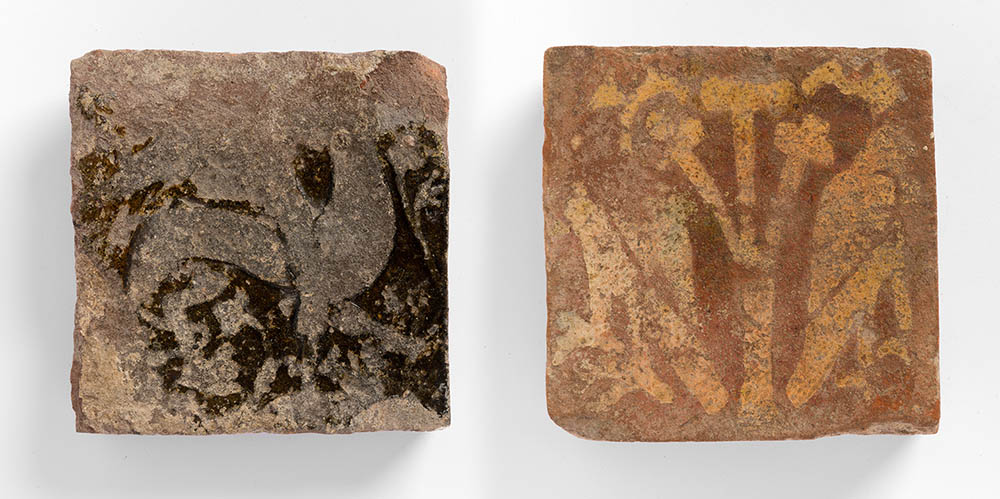

It’s a hot Friday afternoon in late summer and we’re all getting just a little bit high after a couple of hours of inhaling heady solvent fumes. Here we are, the curator, the writer, the photographer - and two fume-emitting bottles of nail varnish. What, you may ask, brings us and the nail varnish together in the cramped space of the Orford Museum store-room? It’s not the most obvious setting for three mature people to be indulging in low-level substance abuse. What we’re actually doing is numbering and photographing 13th century floor tiles. Stowed in piles of assorted crates, scores of the newly loaned tiles await our attention.
The curator, Jen Hall, is in charge. Before being photographed, every tile must have an accession number written onto its reverse. Our work process goes like this. First Jen covers the work-table with rows of archival plastic bags which she has numbered. Next she hands me tiles, face down, one at time, and I carefully lay each one reverse-side up on a bag. Jen keeps a list on which she jots down a brief description of the image on each tile. Then, we set to work with the transparent nail polish, painting a small patch onto the back of each tile to seal the porous clay. We check often to see if the polish is dry. When it is, we work with special pens copying the unique nine digit accession number off each bag and onto the varnished patch on the tile. Next we seal the number with another coat of nail varnish. As soon as the second coat dries, we pass the tiles in strict numerical order to Peter who photographs each one right side up. Once photographed, each tile is put into its own numbered bag and the bagged tiles are laid out in long lines on the floor. Then we set out more bags, more tiles and begin the cycle again. We keep going like this until, with all the available floor space covered, we are, ironically, in danger of treading on the tiles.
Simple? Not quite. In practice the work is problematic. The accession numbers are long and repetitive so it’s all too easy to transpose, repeat or omit digits.The nail polish is problematic, slow-drying and apt to clog the needle-fine nibs of our pens. The tiles are problematic too, many of them badly pitted and chipped, making our pens skid off course. Ideally the numbers should be neat, but as I write grotesquely deformed digits, the ethics of the process suddenly feel problematic too. Guiltily, I feel as if I’m actually defacing the beautiful medieval tiles. Driving home from this first tiring session, I realise that I was so intent on number-writing that I didn’t turn over a single tile to see its decorated face - the very thing that I had so wanted to do. I ask
myself, how did we get to be involved in this surprisingly tricky and attention-consuming process?

The short answer is that, technically, we gatecrashed our way in. Several weeks earlier, when the Orford and District Local History Bulletin arrived, I thought it was my lucky day. An article by Jen Hall described the medieval tile collection recently loaned by Sir Edward Greenwell to the museum. It also described the visit of two tile experts, David Sherlock and Paul Drury, who had come to sort and study the tiles which originated from Butley Priory in Suffolk. Looking at the photos illustrating the article, I instantly hatched an ambition to see the tiles first-hand, so without further ado, I fired off a hopeful email to Jen.
“Why?” was the inevitable question Jen asked as soon as we met. Why indeed. I explained our interest by telling Jen that we live in a cottage standing on land that once formed the precinct of Butley Priory, admitting that we have become pretty well obsessed with anything and everything to do with the Priory. I described the daily walks we take around the Priory’s various remains, both the visible overground ones like the spectacularly impressive gatehouse and adjacent ruined archway, and the invisible underground ones in the neighbouring paddock we rent.
The paddock is especially fascinating to us, as it is the site of the long-vanished abbey church itself - the very place that the tiles were retrieved from. I spoke too of how my interest in the Priory tiles really took off in 2013 when major renovations were carried out in a dilapidated barn that stands on the site of important Priory buildings - the refectory and the cellarer’s range. Searching furtively through a spoil heap left by the contractors, I found shards of beautifully decorated medieval tile, just two tiny shreds of the original fabric of the place.
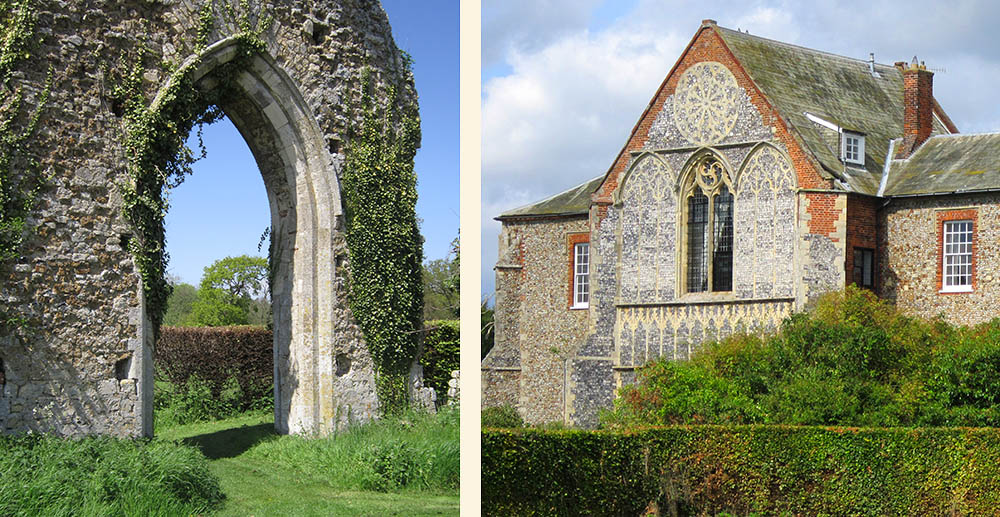
When Jen responded by inviting us to help her with work on cataloguing the tiles, I accepted instantly and Peter found himself ‘volunteered’ for his professional photographic skills. Our meeting had yielded far more than just the private view of the tiles I’d hoped for; we were about to begin several months of close contact with them, meeting Jen and her successor, Jenna Ingamells, many times between autumn 2017 and spring
2018.

Sometimes, during subsequent sessions at the museum-store, when we were working and beginning to succumb to the influence of the nail polish fumes, I’d catch myself daydreaming about daydreams. Mentally I would revisit the countless times I’ve stood at the barn doorway imagining how the complete medieval floor might have looked when sunlight picked out the tiles’ reds and golds and the complicated interlacing of their geometric patterns.
In every session we worked with examples of unique tiles as well as long runs of repeats, maybe ten at a time all decorated with the same design. The tile motifs are intricately detailed and beautiful. They include rosettes and petals, lions rampant, fleur-de-lys, shields, interlaced knots, eagles, stars, leaves, trailing vines and more. The unvarying three-colour scheme of inky black, brick red and golden amber may be simple, but it is rich and striking. To help identify the designs on incomplete tiles or tiny fragments, Jen and Jenna often used a copy of David Sherlock’s book to puzzle out whether we were seeing the wing of a gryphon or a bird, a hop or a vine, a leaf’s tip or a shield’s point.
When long series of identical tiles emerged from the crates, we laid them out just as as the pavers did, trying to see just how the bigger composite design worked. The linked patterns demonstrated how the Priory’s paved floors would have had the same richness and complexity as patchwork quilts, sumptuous embroidered brocades or luxurious Persian rugs.
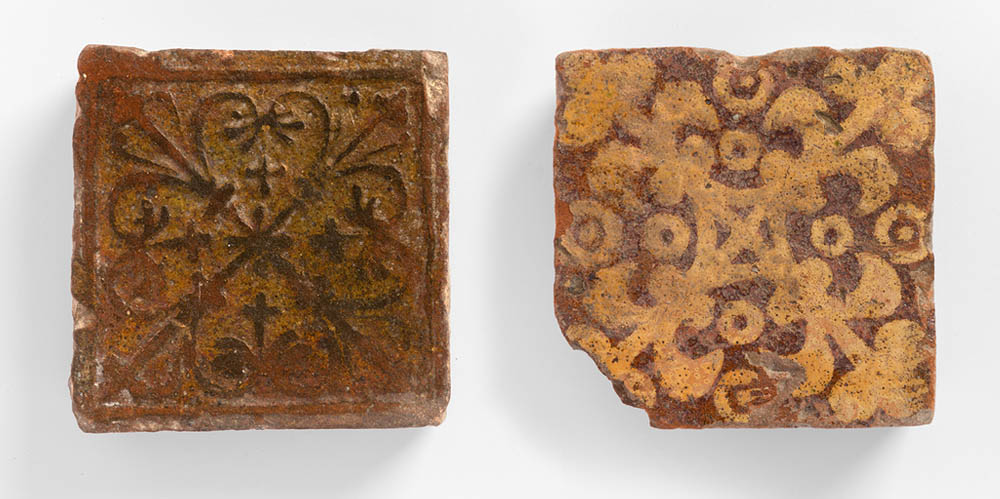
I made another lucky find in a 1950s book containing a large fold-out ground-plan of the priory site drawn by archaeologists during excavations in 1931-32. On this, several places within the abbey church, aka the paddock, are clearly marked ‘tile pavement in situ’. That phrase, in situ, is ambiguous and so tantalising. Did the archaeologists mean that they found the pavements in place and then trowelled all the best tiles out? Or did they mean that they found tiles, removed some samples and left the rest where they were? Are undiscovered tiles still lying in the areas left untouched by the archaeologists?
During the project, we invited Jen and Jenna to come to the paddock. We took them to stand on the exact spots where the archaeologists had located tile pavements. The places are easy to identify because Peter created an intriguing image of the place that is part photograph, part drawing. He did this by juxtaposing the archaeologists’ plan over an aerial photograph of the abbey church site. Standing staring across the paddock at the area where the nave and aisles lay, we could all, as if in x-ray vision, see through the layers of turf and soil into huge expanses of undisturbed tiles. Remembering the motifs and colours of the tiles, we walked up and down the length and width of the aisles conjuring the sights of the vanished church and the tile spreads that might still be buried underfoot.
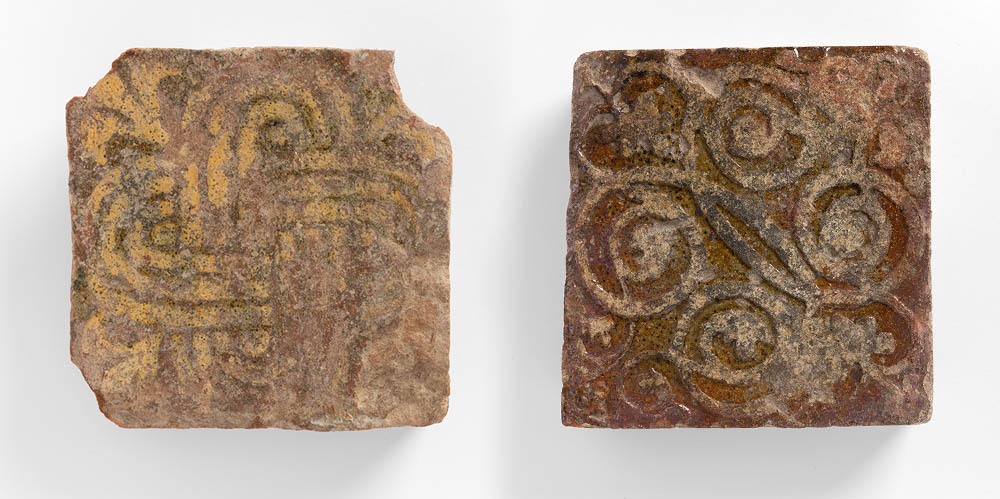
Picturing a thing is a way of possessing it, or at least getting into closer touch with it. When Peter and I looked at the photographs on the computer, we saw the tiles differently and asked different questions of them. There are 285 images, some of whole tiles, some of slightly broken tiles and some of small groups of fragments. Looking at the enlarged images on screen, I became curious about the numbers of tiles that the priory’s floors might have contained. I know that each tile measures 5 x 5 inches, giving an area of 25 square inches per tile. I estimated that the museum’s approximately 285 piece tile collection would therefore equate to an area of just under 50 square feet, only enough to cover the floor of a very small room, say a modern downstairs loo or utility room. I found this somehow disappointing, less impressive than I’d hoped: the tiles seemed to occupy so much more space, both physical and mental, while we were working with them.
But then, using the archaeologists’ measurements, and some leaps of the imagination, I undertook some ambitious guesstimating. The 1930s plans show that the church’s nave alone measured 235 x 65 feet. Its square footage of 152,75 ft would therefore have taken around 88,000 tiles to pave. Even if highly decorated tiles were used only for paving special areas, the rest of the floor might still have been laid with plain tiles. It’s a lot of tiles, but I didn’t calculate for the remainder of the church’s floor space. How many more might have been used for the flooring of the mysterious un-excavated spaces of the chancel underneath my neighbour’s cottage floors, and the lady chapel whose remains lie deep under the roots of the wood?
And then of course my two fragments from the spoil heap imply the existence of pavings in the refectory and chapter house, both places where important guests, including royalty, were entertained. The astronomical total I’ve already calculated rises ever higher. Now it’s the scale of the numbers, not the nail polish, making my head spin. Next, I took the opposite tack and calculated for a conservative minimum number instead. I looked again at the 1930s plans and counted out the eight separately marked tile pavement locations. There was no indication of the extent of the ones marked in the large spaces of the nave and the cellarer’s range, but the smallest ones, clustered around the church’s transept and bounded by walls, measure approximately ten feet by ten feet. Assuming that every one of the eight pavements had this same small measurement, their combined minimum of 800 square feet would require a ‘mere’ 4,608 tiles.
Whichever way I read the vague ambiguities of the plans, and whatever mathematical tricks I turned, I knew that the true totals would always elude me. All I could say was that the Priory might have contained something between 5,000 and well over 100,000 tiles. My maths gave no real answers, except that ultimately the museum’s assorted 285 tiles equate to about enough to cover just half of one of the smallest pavements discovered in the 1930s.
Leaving my inventive statistics aside, I returned to Jen’s article which mentions how ‘it is thought that other excavated tiles still remain stored elsewhere on the [landowner’s] estate’. First I asked myself the small question, so where are the rest? And then the bigger question, where are the rest of the rest? What has happened to the far larger numbers of tiles that both my generous and my conservative calculations hint at? I imagine the best ones being ruthlessly prised up and carried away by the cart load. In a medieval version of re-cycling, they might have been re-laid in prestigious local houses built after the abbey’s post-Reformation dereliction - houses whose own fabric has long since gone the same way as the abbey church - into oblivion. And what of the worn out tiles, the ones already centuries old at the time of the Priory’s demise? Well, there must always have been a demand, then as now, for the anonymous rubble of hard core.

Every session, as we work with pens, camera and nail varnish, we feel the effects of the solvent fumes. The mild headaches we develop are a minor occupational hazard easily cured with fresh air and aspirin. But as my head becomes heavier, I drift into thinking of what the makers of the tiles might have suffered in their work. In imagined retrospect, I slip from inhabiting the present moment in the low-lit store-room back to a time seven or eight centuries ago. Daydreaming again, I visualise generations of men, labourers and craftsmen, toiling at the other, far more arduous, end of the tile production process.
Clay work is hard work, really hard work - from the backbreaking spadework of digging up sodden deadweight clay, through to the mixing and preparing of raw materials and the loading and unloading of kilns: every part of the process involves weight-lifting, continuous heavy labour. It is also dangerously toxic work as glaze recipes are often heavy on lead and other lethal poisons. Wherever there is clay, there is also clay dust that accumulates particle on suffocating particle in the lungs of clay workers. It’s unsurprising that one of the vernacular names for psilicosis is ‘potters' rot’.
Through the fume-induced fog of my slight headache, I imagine the greater pains felt by tile-makers in their aching arthritic backs, the soreness of their chapped and chilblained fingers, the never-ending irritation of dermatitis, the debilitation caused by bronchitic coughing fits. I also see the baldness, toothlessness and blue toned complexion that were sure signs of lead-poisoning. All of these were once part and parcel of the lives of clay-workers. I think too of the permanently bent spines and chronically sore knees of the tilers who knelt for hours at a stretch patiently setting the tiles into perfect place. Long before a health and safety conscious era, the tiles came at the cost of all this unacknowledged human expense: pain and illness inhabit the flip-side of the tiles’ exuberant array of flourishing flora and fauna.
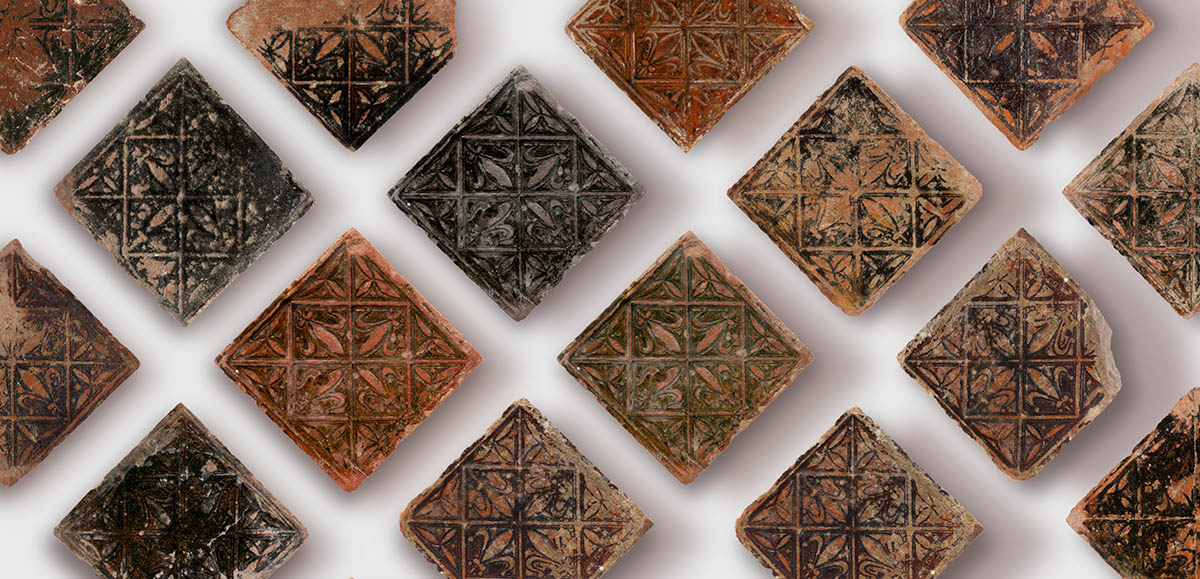
While poring over the fine detail of the images on the computer screen, my eye is caught by some small imperfections in the surface of one tile. In the glaze, I notice a minute hole, no bigger than a pin-prick. Despite its tiny diameter, the hole acts as another lens allowing a glimpse back through the centuries to the day when the tile was at the glaze stage, almost finished.
Through the aperture opened by this blemish, I peer into the hectic scene in the tile-makers’ workshop. Butley’s impatient Prior has sent word, urgently hurrying the floor-tile order along. His message launches the tile-makers into industrious turmoil. Stacks of tiles are ready for glazing; more are coming along the production line: the backlog must be cleared, and fast.
Overnight, as every night, the glaze mixture’s solid particles have sunk and settled into a thick, unyielding sludge. Under pressure, an inexperienced apprentice is given the job preparing the glaze. Instead of stirring the mix slowly, he hurries, over-zealously beating the glaze into a bubbly froth. This is a mistake. The
quicker he stirs, the more the liquid traps small air bubbles. The boy doesn’t know that the bursting of these bubbles will create tiny and permanent tell-tale holes in the glaze. He doesn’t realise that, after the firing, these will be visible to his master, and to the Prior. Nor does he know that, in the far distance of the 21st century, I too will notice them, photographically repeated and emphasised on my illuminated screen. He cannot imagine how they will foreshorten the distance of the centuries, all that has settled between him and me.
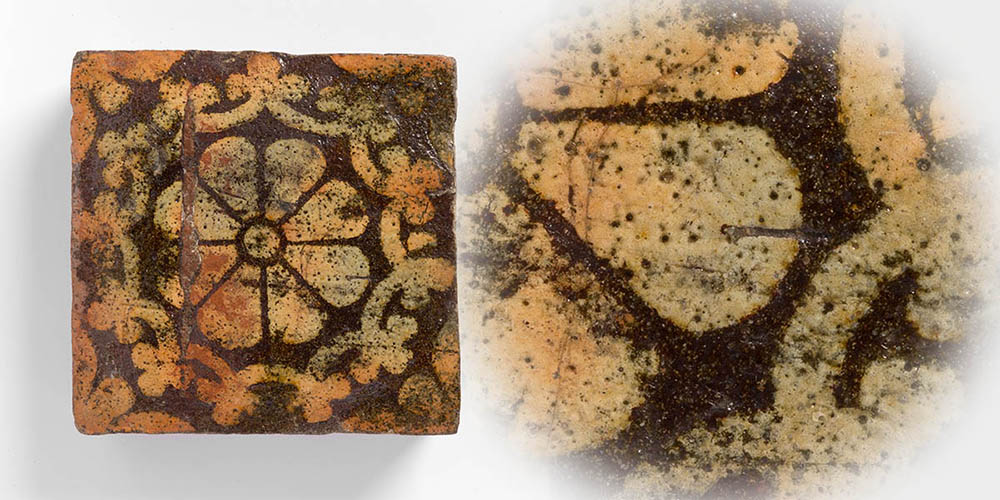
Our numbering and photography sessions are the most recent events in a retrieval process begun by archaeologists almost a century ago. What we did has been part of a disjunctive, but ongoing attempt to know the tiles, to learn their origins and meanings. To me, the work always felt multi-layered. Like so much other museology, it inevitably involved time spent literally piecing together physical fragments, the compilation of a coherent collection. We worked with the aim of bringing that collection into future contact with other people, and into relationships with other objects, other knowledges. We spent time too on a kind of mental patch-working: for us imagination, insight and hindsight became just as much enmeshed as the entwining beasts, birds and plants we saw on the tiles. Such intuitive thinking may be unratified in museum circles, but it certainly enriched and deepened my appreciation of the chance to handle and cherish the tiles.
We didn’t say as much amongst ourselves, but I think we all recognised that our work was a small act of restitution. For too long the tiles had been disregarded, disconnected from the abbey, lost, out of place. Even if they could never be reinstated at the Priory, our modest work with these displaced objects was a means towards helping to ensure that they would be securely accommodated, cared for and appreciated.
Although the numbering and photographing was repetitive, mechanical and, at times, downright mundane, we knew its value. We were relocating the tiles in the here and now, reinvesting them with worth. By bringing them under the protection of the museum system, we were helping them back into cultural place. And that was something that carried an unspoken emotive charge. We were aware that, from the safe distance of the intervening centuries, we could afford to make this restitutive act of defiance. Our work in the store-room, and my subsequent writing about it, serve as retorts, retaliations, ways of answering back to Henry VIII himself and what he did, not only to Butley’s Priory, but to countless others. We were making a very tiny, but very worthwhile, repair to the massive breakages that the Reformation had inflicted on English art.

Sometimes, during certain dank autumn twilights, I see the ghost of the abbey church resurrected in the part of the paddock directly beyond the arch. As fog begins to form, it thickens here and there, gradually sketching the spectral shapes of the nave, the aisles. Given foggy substance, the ghosts of long-vanished walls slowly rise. Miraculously, the vaporous edifice of the church materialises, made of nothing more than mist. I have tried to logically explain this apparition to myself: perhaps vestigial underground rubble from the church’s ruins hold and release warmth and moisture differently from the surrounding virgin soil? Or perhaps the arrangement of old walls and hedges enclosing the field make the fog behave differently, holding it in a micro-climate? But in the days around All Hallows, when darkness falls soon after three and owls begin calling in the wood, it hard to resist the idea that something of the abbey, some lingering essence of the place’s past is reasserting itself, giving a reminder of an enduring presence. Maybe. But what I am more sure of is this: when the flowers and grasses re-carpet the paddock every spring - when their roots thread down through the earthy underlay - then the very shapes of those newest leaves and petals are echoed by the ones that bloom in perpetuity amongst the residues and relics buried below.

My thanks to Orford Museum’s curators, Jen Hall and Jenna Ingamells, for enabling me to have the pleasure of working with the Butley Priory tiles.
All images of the tiles are by Peter White (FXP Photography) and are used by kind permission of Orford Museum.
I am also grateful to Sir Edward Greenwell for letting the Abbey Paddock to me and thereby allowing my close daily contact with Butley Priory’s intriguing remains.
Kim Crowder, September 2018.